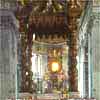 Text search Text search
 Related images Related images
 HistoryWorld HistoryWorld
 Link Link
 Map Map
Click the icons to visit linked content. Hover to see the search terms. |
|  |
| | | | | | | |
|
| 1622 |
| | | Bernini's youthful Pluto and Proserpina, suggesting soft flesh in cold marble, introduces the lively tradition of baroque sculpture | |   
| |
|
| 1622 |
| | | The Flemish painter Anthony van Dyck begins a five-year stay, and a successful career as a portrait painter, in Genoa | |  
| |
|
| 1624 |
| | | Nicolas Poussin arrives in Rome, where he develops the tradition of French classicism | |   
| |
|
| 1627 |
| | | Claude Lorrain, basing himself like Poussin in Rome, paints classical landscapes suffused in light | |   
| |
|
| 1629 |
| | | The sculptor and architect Giovanni Lorenzo Bernini is given the task of adding the drama of baroque to the newly completed St Peter's in Rome | |    
|  | Bernini's Baldacchino in St Peter's
Fotofile CG
|
|
|
| 1632 |
| | | The Inquisition convicts Galileo of heresy and he denies the truth of Copernicus - on being shown the instruments of torture | |   
| |
|
| 1634 |
| | | Francesco Borromini begins work on his intricate baroque masterpiece, the Monastery of San Carlo alle Quattro Fontane (1634-43), in Rome | | 
| |
|
| 1637 |
| | | The first public opera house, the Teatro San Cassiano, opens in Venice | |  
| |
|
| 1638 |
| | | Galileo's Discorsi, published in Leiden, lays the groundwork for mathematical physics | |   
| |
|
| 1643 |
| | | Evangelista Torricelli, observing variations in a column of mercury, discovers the principle of the barometer | |   
| |
|
| | | | | |
| |